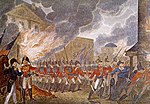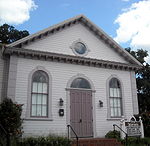Masjid Muhammad
1960 establishments in Washington, D.C.African-American history of Washington, D.C.Former Nation of Islam mosquesMosques in Washington, D.C.Sunni mosques in the United States ... and 1 more
Truxton Circle
Masjid Muhammad is an historically African-American mosque in Washington, D.C. Founded in 1960 as Nation of Islam Temple 4, the mosque is now affiliated with Sunni Islam. It is the second oldest mosque in Washington, D.C. and the city's oldest mosque founded by African-American descendants of enslaved people. Masjid Muhammad is commonly referred to as "The Nation's Mosque".
Excerpt from the Wikipedia article Masjid Muhammad (License: CC BY-SA 3.0, Authors).Masjid Muhammad
4th Street Northwest, Washington
Geographical coordinates (GPS) Address Website External links Nearby Places Show on map
Geographical coordinates (GPS)
| Latitude | Longitude |
|---|---|
| N 38.91034 ° | E -77.01593 ° |
Address
Masjid Muhammad
4th Street Northwest 1519
20001 Washington
District of Columbia, United States
Open on Google Maps











